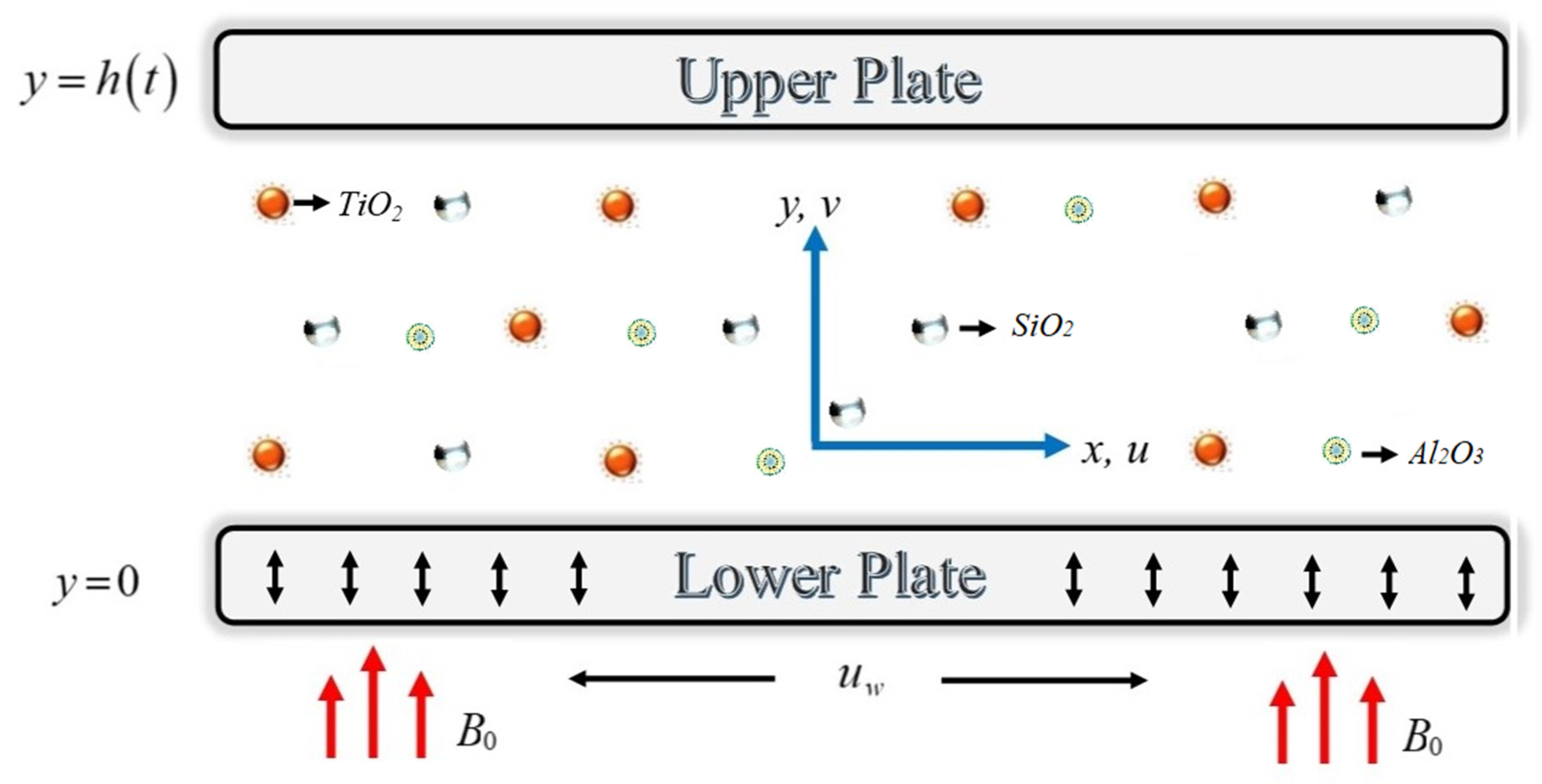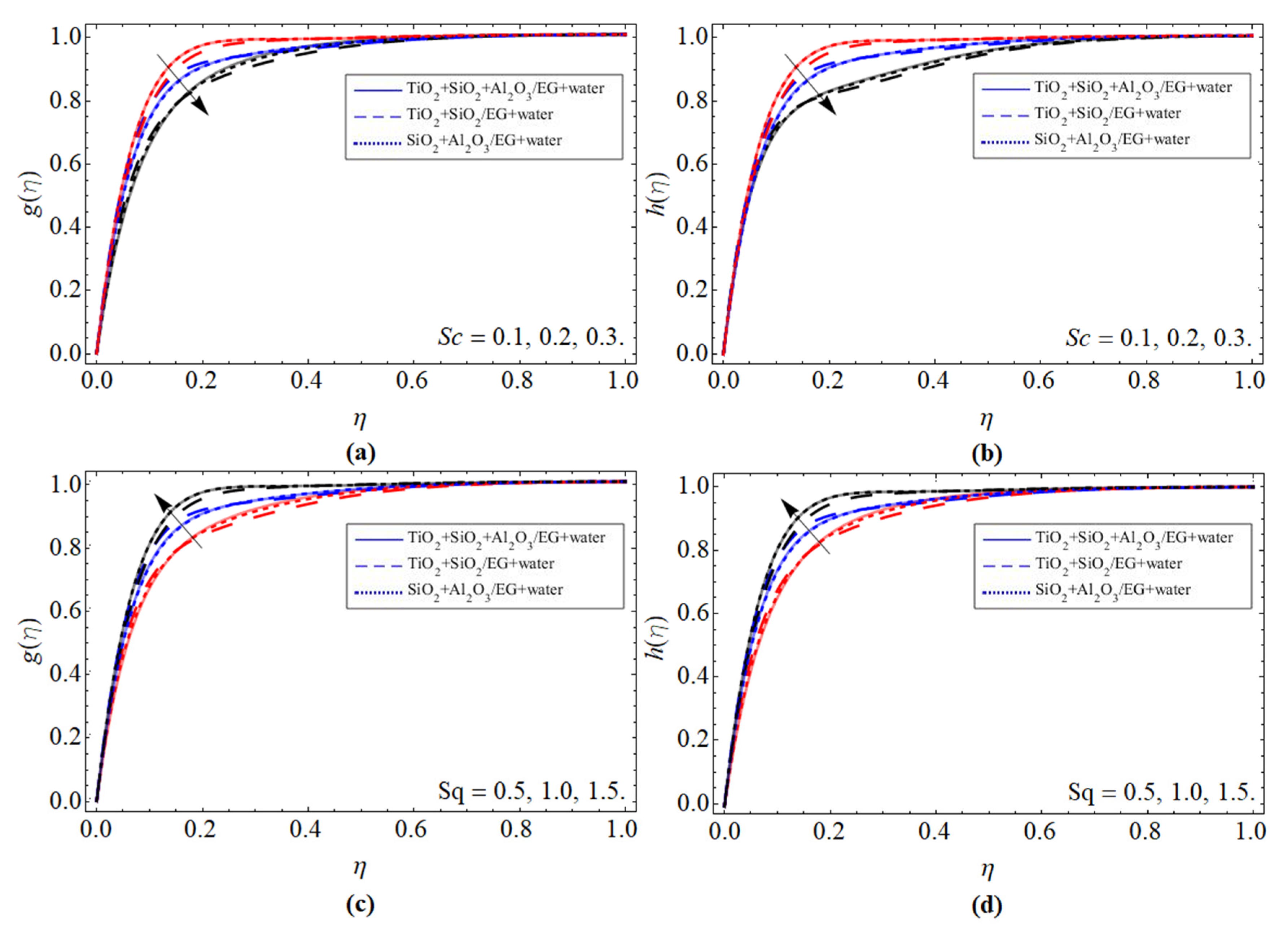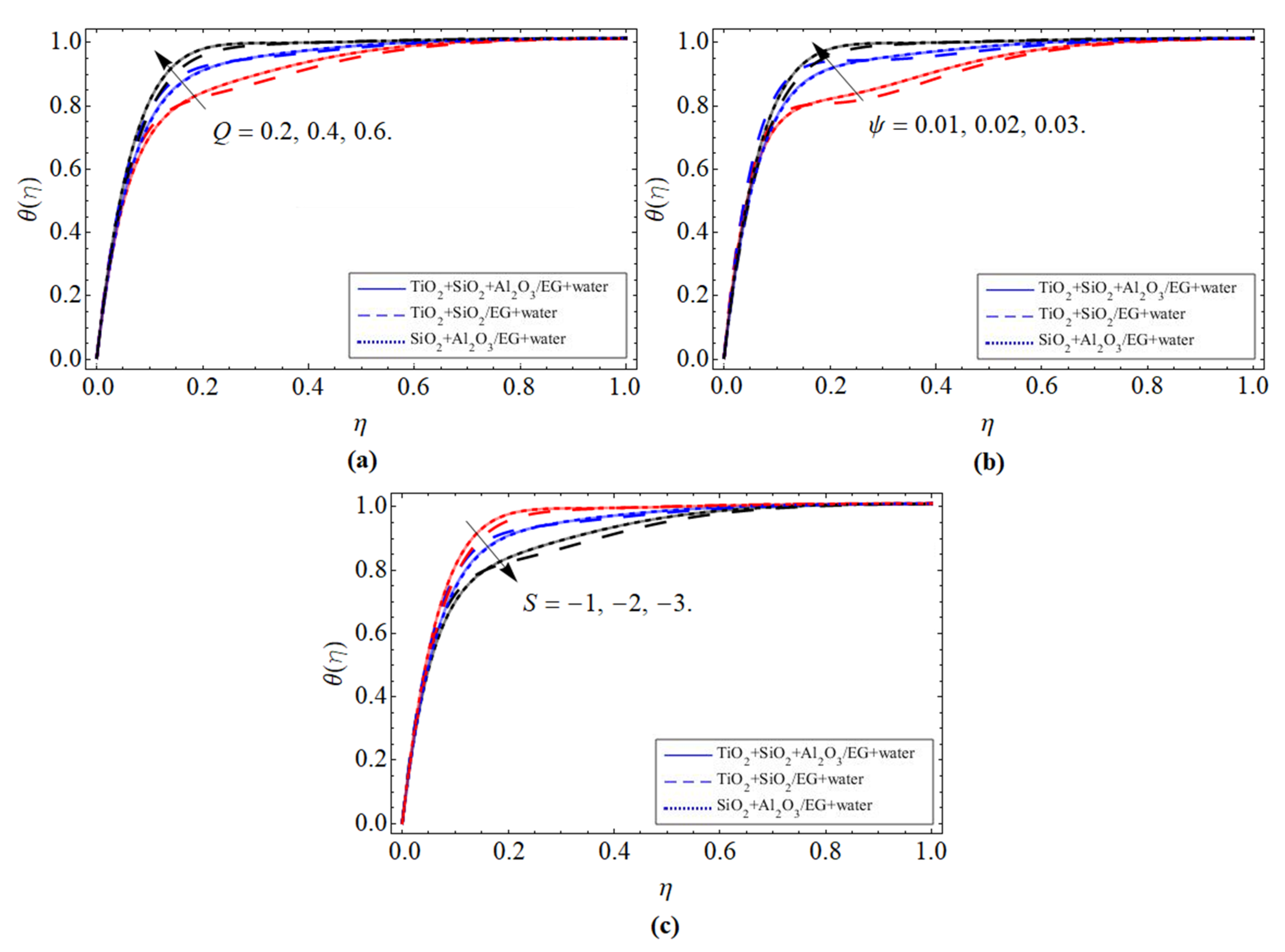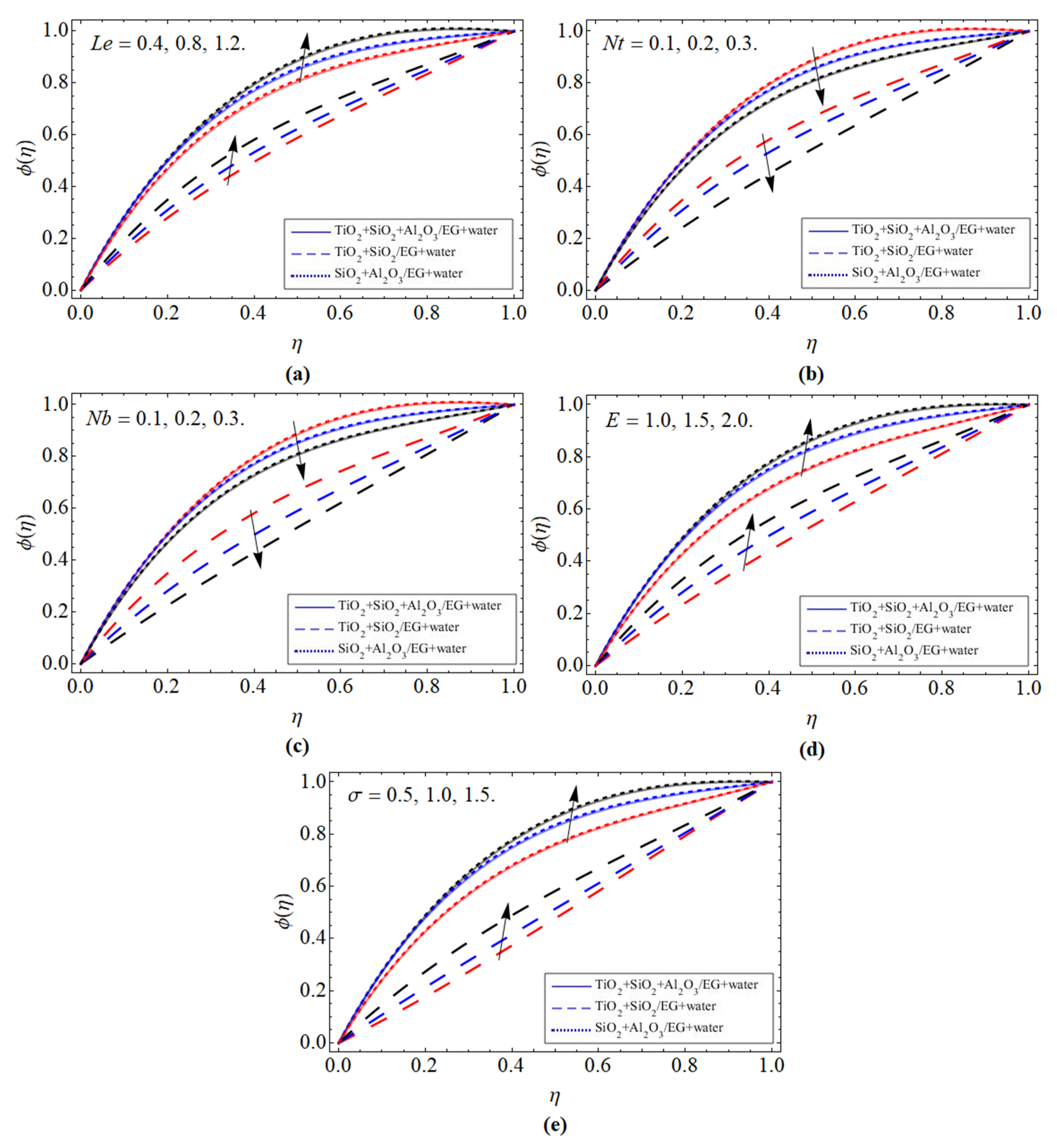Numerical Analysis of an Unsteady, Electroviscous, Ternary Hybrid Nanofluid Flow with Chemical Reaction and Activation Energy across Parallel Plates
Abstract
:1. Introduction
2. Governing Equations
3. Numerical Solution
4. Results and Discussion
5. Conclusions
- The velocity field f′(η) is reduced with the effect of the suction parameter, Darcy–Forchheimer, and magnetic field.
- The flourishing values of injection and volume friction of ternary nanoparticles (TiO2, SiO2, Al2O3) accelerate the velocity distribution.
- The electric field (g(η), h(η)) declines with the upshot of Schmidt number Sc, while enhancing with the increment of squeezing term Sq.
- The thermal energy field θ(η) is elevated versus the variation of heat source and the inclusion of nanomaterials to the base fluid, while reducing with injection effect.
- The mass allocation rate boosts with the rising values of Lewis number, activation energy constraint E, and chemical reaction, while declines with the upshot of thermophoresis and Brownian motion.
Author Contributions
Funding
Data Availability Statement
Acknowledgments
Conflicts of Interest
References
- Jackson, J. A Study of Squeezing Flow. Appl. Sci. Res. Sec. A 1963, 11, 148–152. [Google Scholar] [CrossRef]
- Muhammad, K.; Hayat, T.; Alsaedi, A.; Ahmad, B. Melting Heat Transfer in Squeezing Flow of Basefluid (Water), Nanofluid (CNTs+ Water) and Hybrid Nanofluid (CNTs+ CuO+ Water). J. Therm. Anal. Calorim. 2021, 143, 1157–1174. [Google Scholar] [CrossRef]
- Eiamsa-Ard, S.; Wongcharee, K.; Sripattanapipat, S. 3-D Numerical Simulation of Swirling Flow and Convective Heat Transfer in a Circular Tube Induced by Means of Loose-Fit Twisted Tapes. Int. Commun. Heat Mass Transf. 2009, 36, 947–955. [Google Scholar] [CrossRef]
- Selimefendigil, F.; Öztop, H.F.; Chamkha, A.J. Role of Magnetic Field on Forced Convection of Nanofluid in a Branching Channel. Int. J. Numer. Methods Heat Fluid Flow 2019, 30, 1755–1772. [Google Scholar] [CrossRef]
- Xu, Y.-J.; Bilal, M.; Al-Mdallal, Q.; Khan, M.A.; Muhammad, T. Gyrotactic Micro-Organism Flow of Maxwell Nanofluid between Two Parallel Plates. Sci. Rep. 2021, 11, 15142. [Google Scholar] [CrossRef]
- Shuaib, M.; Bilal, M.; Qaisar, S. Numerical Study of Hydrodynamic Molecular Nanoliquid Flow with Heat and Mass Transmission between Two Spinning Parallel Plates. Phys. Scr. 2020, 96, 025201. [Google Scholar] [CrossRef]
- Ahmadian, A.; Bilal, M.; Khan, M.A.; Asjad, M.I. The non-Newtonian Maxwell Nanofluid Flow between Two Parallel Rotating Disks under the Effects of Magnetic Field. Sci. Rep. 2020, 10, 17088. [Google Scholar] [CrossRef]
- Bilal, M.; Gul, T.; Alsubie, A.; Ali, I. Axisymmetric Hybrid Nanofluid Flow with Heat and Mass Transfer amongst the Two Gyrating Plates. ZAMM–J. Appl. Math. Mech./Z. Angew. Math. Mech. 2021, 101, e202000146. [Google Scholar] [CrossRef]
- Chu, Y.-M.; Shankaralingappa, B.; Gireesha, B.; Alzahrani, F.; Khan, M.I.; Khan, S.U. Combined Impact of Cattaneo-Christov Double Diffusion and Radiative Heat Flux on Bio-Convective Flow of Maxwell Liquid Configured by a Stretched Nano-Material Surface. Appl. Math. Comput. 2022, 419, 126883. [Google Scholar] [CrossRef]
- Zhao, T.H.; Khan, M.I.; Chu, Y.M. Artificial Neural Networking (ANN) Analysis for Heat and Entropy Generation in Flow of Non-Newtonian Fluid between Two Rotating Disks. Math. Methods Appl. Sci. 2021. [Google Scholar] [CrossRef]
- Khan, Z.; Ali, F.; Andualem, M. Free Convection Flow of Second Grade Dusty Fluid between Two Parallel Plates using Fick’s and Fourier’s Laws: A Fractional Model. Sci. Rep. 2022, 12, 3448. [Google Scholar] [CrossRef] [PubMed]
- Alsallami, S.A.; Zahir, H.; Muhammad, T.; Hayat, A.U.; Khan, M.R.; Ali, A. Numerical Simulation of Marangoni Maxwell Nanofluid Flow with Arrhenius Activation Energy and Entropy Anatomization over a Rotating Disk. Waves Random Complex Media 2022, 1–19. [Google Scholar] [CrossRef]
- Dawar, A.; Saeed, A.; Kumam, P. Magneto-Hydrothermal Analysis of Copper and Copper Oxide Nanoparticles between Two Parallel Plates with Brownian Motion and Thermophoresis Effects. Int. Commun. Heat Mass Transf. 2022, 133, 105982. [Google Scholar] [CrossRef]
- Chamkha, A.J. On Laminar Hydromagnetic Mixed Convection Flow in a Vertical Channel with Symmetric and Asymmetric wall Heating Conditions. Int. J. Heat Mass Transf. 2002, 45, 2509–2525. [Google Scholar] [CrossRef]
- Singh, R.; Bishnoi, J.; Tyagi, V.K. Triple Diffusive Convection with Soret–Dufour Effects in a Maxwell Nanofluid Saturated in a Darcy Porous Medium. SN Appl. Sci. 2020, 2, 704. [Google Scholar] [CrossRef] [Green Version]
- Darbari, A.M.; Alavi, M.A.; Saleh, S.R.; Nejati, V. Sensitivity Analysis of Nanofluid Flow over Different Flat Tubes Confined between two Parallel Plates using Taguchi Method and Statistical Analysis of Variance. Int. J. Therm. Sci. 2022, 173, 107428. [Google Scholar] [CrossRef]
- Vickers, N.J. Animal Communication: When i’m calling you, will you answer too? Curr. Biol. 2017, 27, R713–R715. [Google Scholar] [CrossRef]
- Zhou, S.-S.; Bilal, M.; Khan, M.A.; Muhammad, T. Numerical Analysis of Thermal Radiative Maxwell Nanofluid Flow over-stretching Porous Rotating Disk. Micromachines 2021, 12, 540. [Google Scholar] [CrossRef]
- Alhowaity, A.; Hamam, H.; Bilal, M.; Ali, A. Numerical Study of Williamson Hybrid Nanofluid Flow with Thermal Characteristics past over an Extending Surface. Heat Transf. 2022, 1–15. [Google Scholar] [CrossRef]
- Al-Mubaddel, F.S.; Allehiany, F.M.; Nofal, T.A.; Alam, M.M.; Ali, A.; Asamoah, J.K.K. Rheological Model for Generalized Energy and Mass Transfer through Hybrid Nanofluid Flow Comprised of Magnetized Cobalt Ferrite Nanoparticles. J. Nanomater. 2022. [Google Scholar] [CrossRef]
- Ullah, I.; Hayat, T.; Alsaedi, A. Optimization of Entropy Production in Flow of Hybrid Nanomaterials through Darcy–Forchheimer Porous Space. J. Therm. Anal. Calorim. 2021, 147, 5855–5864. [Google Scholar] [CrossRef]
- Elattar, S.; Helmi, M.M.; Elkotb, M.A.; El-Shorbagy, M.; Abdelrahman, A.; Bilal, M.; Ali, A. Computational Assessment of Hybrid Nanofluid Flow with the Influence of Hall Current and Chemical Reaction over a Slender Stretching Surface. Alex. Eng. J. 2022, 61, 10319–10331. [Google Scholar] [CrossRef]
- Alharbi, K.A.M.; Ahmed, A.E.-S.; Ould Sidi, M.; Ahammad, N.A.; Mohamed, A.; El-Shorbagy, M.A.; Bilal, M.; Marzouki, R. Computational Valuation of Darcy Ternary-Hybrid Nanofluid Flow across an Extending Cylinder With Induction Effects. Micromachines 2022, 13, 588. [Google Scholar] [CrossRef] [PubMed]
- Ullah, Z.; Ullah, I.; Zaman, G.; Sun, T.C. A Numerical Approach to Interpret Melting and Activation Energy Phenomenon on the Magnetized Transient Flow of Prandtl–Eyring Fluid with the Application of Cattaneo–Christov Theory. Waves Random Complex Media 2022, 1–21. [Google Scholar] [CrossRef]
- Nguyen, Q.; Rizvandi, R.; Karimipour, A.; Malekahmadi, O.; Bach, Q.-V. A Novel Correlation to Calculate Thermal Conductivity of Aqueous Hybrid Graphene Oxide/Silicon Dioxide Nanofluid: Synthesis, Characterizations, Preparation, and Artificial Neural Network Modeling. Arab. J. Sci. Eng. 2020, 45, 9747–9758. [Google Scholar] [CrossRef]
- Khan, M.I.; Khan, S.A.; Hayat, T.; Waqas, M.; Alsaedi, A. Modeling and Numerical Simulation for Flow of Hybrid Nanofluid (SiO2/C3H8O2) and (MoS2/C3H8O2) with Entropy Optimization and Variable Viscosity. Int. J. Numer. Methods Heat Fluid Flow 2019, 22, 3939–3955. [Google Scholar] [CrossRef]
- Zhang, X.-H.; Algehyne, E.A.; Alshehri, M.G.; Bilal, M.; Khan, M.A.; Muhammad, T. The Parametric Study of Hybrid Nanofluid Flow with Heat Transition Characteristics over a Fluctuating Spinning Disk. PLoS ONE 2021, 16, e0254457. [Google Scholar] [CrossRef]
- Ahmed, J.; Shahzad, A.; Farooq, A.; Kamran, M.; Ud-Din Khan, S.; Ud-Din Khan, S. Thermal Analysis in Swirling Flow of Titanium Dioxide–Aluminum Oxide Water Hybrid Nanofluid over a Rotating Cylinder. J. Therm. Anal. Calorim. 2021, 144, 2175–2185. [Google Scholar] [CrossRef]
- Chu, Y.M.; Bashir, S.; Ramzan, M.; Malik, M.Y. Model-Based Comparative Study of Magnetohydrodynamics Unsteady Hybrid Nanofluid Flow between Two Infinite Parallel Plates with Particle Shape Effects. Math. Methods Appl. Sci. 2022. [Google Scholar] [CrossRef]
- Chu, Y.-M.; Nazir, U.; Sohail, M.; Selim, M.M.; Lee, J.-R. Enhancement in Thermal Energy and Solute Particles using Hybrid Nanoparticles by Engaging Activation Energy and Chemical Reaction over a Parabolic Surface via Finite Element Approach. Fract. Fract. 2021, 5, 119. [Google Scholar] [CrossRef]
- Long, X.; Yang, S.; Qiu, X.; Ding, D.; Feng, C.; Chen, R.; Wang, X.; Chen, N.; Lei, Q. Heterogeneous Activation of Peroxymonosulfate for Bisphenol A Degradation using CoFe2O4 Derived by Hybrid Cobalt-Ion Hexacyanoferrate Nanoparticles. Chem. Eng. J. 2021, 404, 127052. [Google Scholar] [CrossRef]
- Ullah, I.; Hayat, T.; Alsaedi, A.; Asghar, S. Dissipative Flow of Hybrid Nanoliquid (H2O-Aluminum Alloy Nanoparticles) with Thermal Radiation. Phys. Scr. 2019, 94, 125708. [Google Scholar] [CrossRef]
- Shah, T.R.; Zhou, C.; Ali, H.M. Titanium Dioxide: Advancements and Thermal Applications. In Titanium Dioxide; Ali, H.M., Ed.; IntechOpen Limited: London, UK, 2022. [Google Scholar] [CrossRef]
- Ullah, I.; Hayat, T.; Aziz, A.; Alsaedi, A. Significance of Entropy Generation and the Coriolis Force on the Three-Dimensional Non-Darcy Flow of Ethylene-Glycol Conveying Carbon Nanotubes (SWCNTs and MWCNTs). J. Non-Equilib. Thermodyn. 2022, 47, 61–75. [Google Scholar] [CrossRef]
- Bilal, M.; Saeed, A.; Gul, T.; Ali, I.; Kumam, W.; Kumam, P. Numerical Approximation of Microorganisms Hybrid Nanofluid Flow Induced by a Wavy Fluctuating Spinning Disc. Coatings 2021, 11, 1032. [Google Scholar] [CrossRef]
- Algehyne, E.A.; Alhusayni, Y.Y.; Tassaddiq, A.; Saeed, A.; Bilal, M. The Study of Nanofluid Flow with Motile Microorganism and Thermal Slip Condition across a Vertical Permeable Surface. Waves Random Complex Media 2022, 1–18. [Google Scholar] [CrossRef]
- Bilal, M.; Saeed, A.; Gul, T.; Kumam, W.; Mukhtar, S.; Kumam, P. Parametric Simulation of Micropolar Fluid with Thermal Radiation Across a Porous Stretching Surface. Sci. Rep. 2022, 12, 2542. [Google Scholar] [CrossRef]
- Bilal, M.; Ayed, H.; Saeed, A.; Brahmia, A.; Gul, T.; Kumam, P. The Parametric Computation of Nonlinear Convection Magnetohydrodynamic Nanofluid Flow with Internal Heating across a Fixed And Spinning Disk. Waves Random Complex Media 2022, 1–16. [Google Scholar] [CrossRef]
- Ullah, I. Activation Energy with Exothermic/Endothermic Reaction and Coriolis Force Effects on Magnetized Nanomaterials Flow through Darcy–Forchheimer Porous Space with Variable Features. Waves Random Complex Media 2022, 1–14. [Google Scholar] [CrossRef]
- Gul, T.; Khan, A.; Bilal, M.; Alreshidi, N.A.; Mukhtar, S.; Shah, Z.; Kumam, P. Magnetic Dipole Impact on the Hybrid Nanofluid Flow over an Extending Surface. Sci. Rep. 2020, 10, 8474. [Google Scholar] [CrossRef]
- Hayat, T.; Noreen, S. Peristaltic Transport of Fourth Grade Fluid with Heat Transfer and Induced Magnetic Field. C. R. Mec. 2010, 338, 518–528. [Google Scholar] [CrossRef]
- Raza, J.; Mebarek-Oudina, F.; Chamkha, A. Magnetohydrodynamic flow of molybdenum disulfide nanofluid in a channel with shape effects. Multidiscip. Modeling Mater. Struct. 2019, 15, 737. [Google Scholar] [CrossRef]
- Dezfulizadeh, A.; Aghaei, A.; Hassani Joshaghani, A.; Najafizadeh, M.M. Exergy Efficiency of a Novel Heat Exchanger under MHD Effects Filled with Water-Based Cu–SiO2-MWCNT Ternary Hybrid Nanofluid based on Empirical Data. J. Therm. Anal. Calorim. 2021, 147, 4781–4804. [Google Scholar] [CrossRef]
- Yuvaraj, T.; Ravi, K. Multi-Objective Simultaneous DG and DSTATCOM Allocation in Radial Distribution Networks using Cuckoo Searching Algorithm. Alex. Eng. J. 2018, 57, 2729–2742. [Google Scholar] [CrossRef]
- Krishna, M.V.; Chamkha, A.J. Hall and Ion Slip Effects on MHD Rotating Flow of Elastico-Viscous Fluid through Porous Medium. Int. Commun. Heat Mass Transf. 2020, 113, 104494. [Google Scholar] [CrossRef]
- Krishna, M.V.; Ahamad, N.A.; Chamkha, A.J. Hall and Ion Slip Impacts on Unsteady MHD Convective Rotating Flow of Heat Generating/Absorbing Second Grade Fluid. Alex. Eng. J. 2021, 60, 845–858. [Google Scholar] [CrossRef]
- Khashi’ie, N.S.; Waini, I.; Arifin, N.M.; Pop, I. Unsteady Squeezing Flow of Cu-Al2O3/Water Hybrid Nanofluid in a Horizontal Channel with Magnetic Field. Sci. Rep. 2021, 11, 14128. [Google Scholar] [CrossRef]
- Khan, M.S.; Shah, R.A.; Ali, A.; Khan, A. Parametric Investigation of the Nernst–Planck Model and Maxwell’s Equations for a Viscous Fluid between Squeezing Plates. Bound. Value Probl. 2019, 2019, 107. [Google Scholar] [CrossRef] [Green Version]
- Khan, M.S.; Shah, R.A.; Khan, A. Effect of Variable Magnetic Field on the Flow between Two Squeezing Plates. Eur. Phys. J. Plus 2019, 134, 219. [Google Scholar] [CrossRef]
- Nazeer, M.; Hussain, F.; Khan, M.I.; El-Zahar, E.R.; Chu, Y.-M.; Malik, M. Theoretical Study of MHD Electro-Osmotically Flow of Third-Grade Fluid in Micro Channel. Appl. Math. Comput. 2022, 420, 126868. [Google Scholar] [CrossRef]
- Shahi, A.M.; Issac, B.; Modapothala, J.R. Intelligent Corporate Sustainability Report Scoring Solution using Machine Learning Approach to Text Categorization. In Proceedings of the 2012 IEEE Conference on Sustainable Utilization and Development in Engineering and Technology (STUDENT), Kuala Lumpur, Malaysia, 6–9 October 2012; pp. 227–232. [Google Scholar]
- Zhao, T.; Wang, M.; Chu, Y. Monotonicity and Convexity Involving Generalized Elliptic Integral of the First Kind. Revista de la Real Academia de Ciencias Exactas, Físicas y Naturales Serie A Matemáticas 2021, 115, 46. [Google Scholar] [CrossRef]
- Shuaib, M.; Shah, R.A.; Bilal, M. Variable Thickness Flow over a Rotating Disk under the Influence of Variable Magnetic Field: An Application to Parametric Continuation Method. Adv. Mech. Eng. 2020, 12, 1687814020936385. [Google Scholar] [CrossRef]
- Zhao, T.-H.; Zhou, B.-C.; Wang, M.-K.; Chu, Y.-M. On Approximating the Quasi-Arithmetic Mean. J. Inequal. Appl. 2019, 2019, 42. [Google Scholar] [CrossRef]
- Zhao, T.-H.; Wang, M.-K.; Zhang, W.; Chu, Y.-M. Quadratic Transformation Inequalities for Gaussian Hypergeometric Function. J. Inequal. Appl. 2018, 2018, 251. [Google Scholar] [CrossRef] [PubMed] [Green Version]
- Rashid, S.; Sultana, S.; Karaca, Y.; Khalid, A.; Chu, Y.-M. Some Further Extensions Considering Discrete Proportional Fractional Operators. Fractals 2022, 30, 2240026. [Google Scholar] [CrossRef]
- Wang, F.; Khan, M.N.; Ahmad, I.; Ahmad, H.; Abu-Zinadah, H.; Chu, Y.-M. Numerical Solution of Traveling Waves in Chemical Kinetics: Time-Fractional Fishers Equations. Fractals 2022, 30, 2240051. [Google Scholar] [CrossRef]
- Manjunatha, S.; Puneeth, V.; Gireesha, B.; Chamkha, A. Theoretical Study of Convective Heat Transfer in Ternary Nanofluid Flowing past a Stretching Sheet. J. Appl. Comput. Mech. 2021. [Google Scholar] [CrossRef]
- Khan, M.S.; Mei, S.; Fernandez-Gamiz, U.; Noeiaghdam, S.; Khan, A. Numerical Simulation of a Time-Dependent Electroviscous and Hybrid Nanofluid with Darcy-Forchheimer Effect between Squeezing Plates. Nanomaterials 2022, 12, 876. [Google Scholar] [CrossRef]





| Base Fluid & Nanoparticles | ρ (kg/m3) | k (W/mK)) | Cp (j/kg K) | σ (S/m) |
|---|---|---|---|---|
| C2H6O2-H20 | 1063.8 | 0.387 | 3630 | 0.00509 |
| TiO2 | 4250 | 8.953 | 686.2 | 2.38 × 106 |
| SiO2 | 2270 | 1.4013 | 3630 | 3.5 × 106 |
| Al2O3 | 6310 | 32.9 | 773 | 5.96 × 107 |
| Viscosity | |
| Density | |
| Specific heat | |
| Thermal conduction | |
| Electrical conductivity |
| Parameters | f″(1) | f″(0) | |||
|---|---|---|---|---|---|
| M | S | Khashi’ie et al. [47] | Present Work | Khashi’ie et al. [47] | Present Work |
| 0.0 | 0.5 | 4.7132028 | 4.7132043 | −7.4101525 | −7.4101542 |
| 1.0 | 4.7391165 | 4.7391176 | −7.5906177 | −7.5906188 | |
| 4.0 | 4.8201511 | 4.8201533 | −8.1113342 | −8.1113363 | |
| 9.0 | 4.9647698 | 4.9647787 | −8.9110956 | −8.9110978 | |
| 0.0 | 1.8423469 | 1.8423476 | −4.5868911 | −4.5868933 | |
| 0.3 | 3.6535948 | 3.6535969 | −6.6646620 | −6.6646632 | |
| 0.6 | 5.3911475 | 5.3911494 | −8.8524442 | −8.8524453 | |
| 1.0 | 7.5933262 | 7.5933283 | −11.9475843 | −11.9475941 | |
| Parameter | Khan et al. [59] (Numerical) | Present Work | Khan et al. [59] (Analytic) | Present Work |
|---|---|---|---|---|
| Sq | ||||
| 0.0 | −0.8443 | −0.8452 | −0.8438 | −0.8445 |
| 0.2 | −0.8791 | −0.8880 | −0.8783 | −0.8794 |
| 0.4 | −0.9151 | −0.9162 | −0.9140 | −0.9153 |
| 0.6 | −0.9523 | −0.9542 | −0.9511 | −0.9532 |
| 0.8 | −0.9908 | −0.9916 | −0.9914 | −0.9935 |
| 1.0 | −1.0306 | −1.0317 | −1.0310 | −1.0332 |
Publisher’s Note: MDPI stays neutral with regard to jurisdictional claims in published maps and institutional affiliations. |
© 2022 by the authors. Licensee MDPI, Basel, Switzerland. This article is an open access article distributed under the terms and conditions of the Creative Commons Attribution (CC BY) license (https://creativecommons.org/licenses/by/4.0/).
Share and Cite
Bilal, M.; Ahmed, A.E.-S.; El-Nabulsi, R.A.; Ahammad, N.A.; Alharbi, K.A.M.; Elkotb, M.A.; Anukool, W.; S. A., Z.A. Numerical Analysis of an Unsteady, Electroviscous, Ternary Hybrid Nanofluid Flow with Chemical Reaction and Activation Energy across Parallel Plates. Micromachines 2022, 13, 874. https://doi.org/10.3390/mi13060874
Bilal M, Ahmed AE-S, El-Nabulsi RA, Ahammad NA, Alharbi KAM, Elkotb MA, Anukool W, S. A. ZA. Numerical Analysis of an Unsteady, Electroviscous, Ternary Hybrid Nanofluid Flow with Chemical Reaction and Activation Energy across Parallel Plates. Micromachines. 2022; 13(6):874. https://doi.org/10.3390/mi13060874
Chicago/Turabian StyleBilal, Muhammad, A. El-Sayed Ahmed, Rami Ahmad El-Nabulsi, N. Ameer Ahammad, Khalid Abdulkhaliq M. Alharbi, Mohamed Abdelghany Elkotb, Waranont Anukool, and Zedan A. S. A. 2022. "Numerical Analysis of an Unsteady, Electroviscous, Ternary Hybrid Nanofluid Flow with Chemical Reaction and Activation Energy across Parallel Plates" Micromachines 13, no. 6: 874. https://doi.org/10.3390/mi13060874
APA StyleBilal, M., Ahmed, A. E.-S., El-Nabulsi, R. A., Ahammad, N. A., Alharbi, K. A. M., Elkotb, M. A., Anukool, W., & S. A., Z. A. (2022). Numerical Analysis of an Unsteady, Electroviscous, Ternary Hybrid Nanofluid Flow with Chemical Reaction and Activation Energy across Parallel Plates. Micromachines, 13(6), 874. https://doi.org/10.3390/mi13060874








